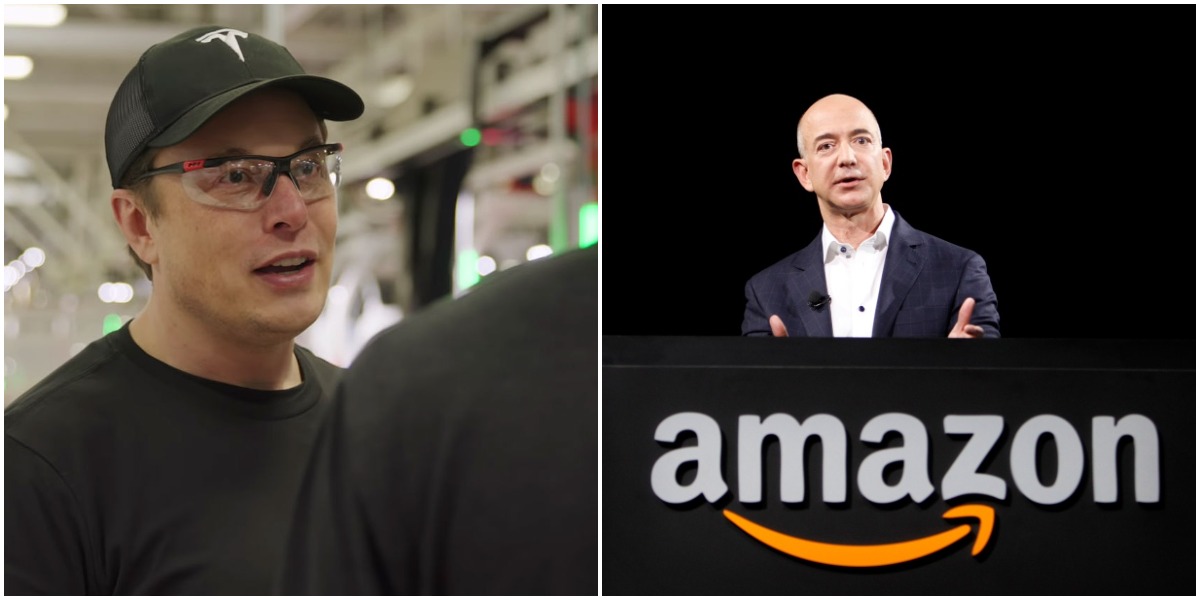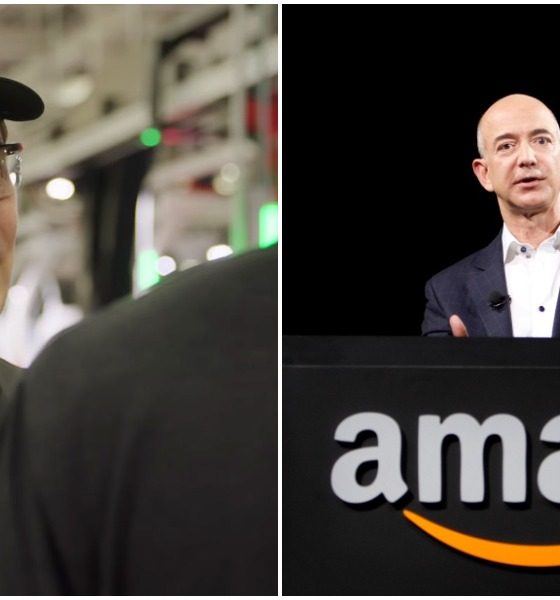

News
Jeff Bezos ponders Tesla’s ‘complexity’ in China following Musk’s Twitter acquisition
Following Elon Musk’s acquisition of social media platform Twitter yesterday, Amazon founder and former CEO Jeff Bezos pondered the potential hoops Tesla, Musk’s automotive company, may have to jump through as a company operating in China. Due to Musk’s purchase of Twitter, Bezos questioned whether China gained “a bit of leverage” over the platform’s censorship, but backtracked.
A Tweet from New York Times reporter Mike Forsythe identified Tesla’s success in the Chinese market. After entering China as an automaker in early 2020, Tesla has experienced success in the market with its Model 3 and Model Y vehicles, which have routinely been identified as a couple of the best-selling EVs in the country. Tesla’s production facility in China, known as Gigafactory Shanghai, outpaced Tesla’s U.S. factory in Fremont, California, in production figures in 2021, accounting for 51.7 percent of the company’s total vehicle deliveries for the year.
Apropos of something:
-Tesla’s second-biggest market in 2021 was China (after the US)
-Chinese battery makers are major suppliers for Tesla’s EVs.
-After 2009, when China banned Twitter, the government there had almost no leverage over the platform
-That may have just changed— Mike Forsythe 傅才德 (@PekingMike) April 25, 2022
Forsythe recognizes this, along with Chinese battery suppliers and their links to Tesla. However, his Tweet begins to also call out China’s ban of Twitter in 2009, and how the government had “almost no leverage over the platform.” With Musk’s purchase yesterday, “That may have just changed,” the Tweet concludes.
Bezos responded and jostled with the question, “Did the Chinese government just gain a bit of leverage over the town square,” using the term as Musk has in the past to compare Twitter to a social gathering of people to discuss ideas and issues. “My own answer to this question is probably not. The more likely outcome in this regard is complexity in China of Tesla, rather than censorship at Twitter.”
My own answer to this question is probably not. The more likely outcome in this regard is complexity in China for Tesla, rather than censorship at Twitter.
— Jeff Bezos (@JeffBezos) April 26, 2022
Musk, who purchased Twitter for $44 billion yesterday, said in the past his reasons for buying Twitter are related to free speech and censorship, is unlikely to see any real changes from China just because he’s bought the platform. Many American social media outlets are unavailable in China because, as the government has described in the past, it is a way to avoid “risks in the ideological field from the Internet.”
The true challenges will occur in China for Tesla; at least, Bezos thinks so. However, the automaker has had a reasonably positive relationship with China and its government, especially as Tesla has expanded operations at its plant, providing thousands of jobs to local workers.
Bezos, whose former company Amazon has done business in China for many years, purchased the Washington Post in 2013. The newspaper had no reservations about challenging Musk’s fight against censorship with stories earlier this month. Musk called the headline, “a good laugh.”
Ouch, I just snorted coffee out of my nose. pic.twitter.com/bDCYhMhdag
— Marc Andreessen (@pmarca) April 5, 2022
Additionally, a report from Dauxe Consulting reported that some 38 percent of Amazon’s top-selling brands were based in China.
Tesla has performed extremely well in China with sales, but it has also had its issues. The company had its vehicles banned from government properties and military bases due to its use of external cameras equipped for Full Self-Driving and Sentry Mode. Tesla’s in-cabin cameras are not active in China.
I’d love to hear from you! If you have any comments, concerns, or questions, please email me at joey@teslarati.com. You can also reach me on Twitter @KlenderJoey, or if you have news tips, you can email us at tips@teslarati.com.

Elon Musk
Elon Musk’s X will start using a Tesla-like software update strategy
The initiative seems designed to accelerate updates to the social media platform, while maintaining maximum transparency.

Elon Musk’s social media platform X will adopt a Tesla-esque approach to software updates for its algorithm.
The initiative seems designed to accelerate updates to the social media platform, while maintaining maximum transparency.
X’s updates to its updates
As per Musk in a post on X, the social media company will be making a new algorithm to determine what organic and advertising posts are recommended to users. These updates would then be repeated every four weeks.
“We will make the new 𝕏 algorithm, including all code used to determine what organic and advertising posts are recommended to users, open source in 7 days. This will be repeated every 4 weeks, with comprehensive developer notes, to help you understand what changed,” Musk wrote in his post.
The initiative somewhat mirrors Tesla’s over-the-air update model, where vehicle software is regularly refined and pushed to users with detailed release notes. This should allow users to better understand the details of X’s every update and foster a healthy feedback loop for the social media platform.
xAI and X
X, formerly Twitter, has been acquired by Elon Musk’s artificial intelligence startup, xAI last year. Since then, xAI has seen a rapid rise in valuation. Following the company’s the company’s upsized $20 billion Series E funding round, estimates now suggest that xAI is worth tens about $230 to $235 billion. That’s several times larger than Tesla when Elon Musk received his controversial 2018 CEO Performance Award.
As per xAI, the Series E funding round attracted a diverse group of investors, including Valor Equity Partners, Stepstone Group, Fidelity Management & Research Company, Qatar Investment Authority, MGX, and Baron Capital Group, among others. Strategic partners NVIDIA and Cisco Investments also continued support for building the world’s largest GPU clusters.
News
Tesla FSD Supervised wins MotorTrend’s Best Driver Assistance Award
The decision marks a notable reversal for the publication from prior years, with judges citing major real-world improvements that pushed Tesla’s latest FSD software ahead of every competing ADAS system.

Tesla’s Full Self-Driving (Supervised) system has been named the best driver-assistance technology on the market, earning top honors at the 2026 MotorTrend Best Tech Awards.
The decision marks a notable reversal for the publication from prior years, with judges citing major real-world improvements that pushed Tesla’s latest FSD software ahead of every competing ADAS system. And it wasn’t even close.
MotorTrend reverses course
MotorTrend awarded Tesla FSD (Supervised) its 2026 Best Tech Driver Assistance title after extensive testing of the latest v14 software. The publication acknowledged that it had previously criticized earlier versions of FSD for erratic behavior and near-miss incidents, ultimately favoring rivals such as GM’s Super Cruise in earlier evaluations.
According to MotorTrend, the newest iteration of FSD resolved many of those shortcomings. Testers said v14 showed far smoother behavior in complex urban scenarios, including unprotected left turns, traffic circles, emergency vehicles, and dense city streets. While the system still requires constant driver supervision, judges concluded that no other advanced driver-assistance system currently matches its breadth of capability.
Unlike rival systems that rely on combinations of cameras, radar, lidar, and mapped highways, Tesla’s FSD operates using a camera-only approach and is capable of driving on city streets, rural roads, and freeways. MotorTrend stated that pure utility, the ability to handle nearly all road types, ultimately separated FSD from competitors like Ford BlueCruise, GM Super Cruise, and BMW’s Highway Assistant.
High cost and high capability
MotorTrend also addressed FSD’s pricing, which remains significantly higher than rival systems. Tesla currently charges $8,000 for a one-time purchase or $99 per month for a subscription, compared with far lower upfront and subscription costs from other automakers. The publication noted that the premium is justified given FSD’s unmatched scope and continuous software evolution.
Safety remained a central focus of the evaluation. While testers reported collision-free operation over thousands of miles, they noted ongoing concerns around FSD’s configurable driving modes, including options that allow aggressive driving and speeds beyond posted limits. MotorTrend emphasized that, like all Level 2 systems, FSD still depends on a fully attentive human driver at all times.
Despite those caveats, the publication concluded that Tesla’s rapid software progress fundamentally reshaped the competitive landscape. For drivers seeking the most capable hands-on driver-assistance system available today, MotorTrend concluded Tesla FSD (Supervised) now stands alone at the top.
News
Elon Musk’s Grokipedia surges to 5.6M articles, almost 79% of English Wikipedia
The explosive growth marks a major milestone for the AI-powered online encyclopedia, which was launched by Elon Musk’s xAI just months ago.

Elon Musk’s Grokipedia has grown to an impressive 5,615,201 articles as of today, closing in on 79% of the English Wikipedia’s current total of 7,119,376 articles.
The explosive growth marks a major milestone for the AI-powered online encyclopedia, which was launched by Elon Musk’s xAI just months ago. Needless to say, it would only be a matter of time before Grokipedia exceeds English Wikipedia in sheer volume.
Grokipedia’s rapid growth
xAI’s vision for Grokipedia emphasizes neutrality, while Grok’s reasoning capabilities allow for fast drafting and fact-checking. When Elon Musk announced the initiative in late September 2025, he noted that Grokipedia would be an improvement to Wikipedia because it would be designed to avoid bias.
At the time, Musk noted that Grokipedia “is a necessary step towards the xAI goal of understanding the Universe.”
Grokipedia was launched in late October, and while xAI was careful to list it only as Version 0.1 at the time, the online encyclopedia immediately earned praise. Wikipedia co-founder Larry Sanger highlighted the project’s innovative approach, noting how it leverages AI to fill knowledge gaps and enable rapid updates. Netizens also observed how Grokipedia tends to present articles in a more objective manner compared to Wikipedia, which is edited by humans.
Elon Musk’s ambitious plans
With 5,615,201 total articles, Grokipedia has now grown to almost 79% of English Wikipedia’s article base. This is incredibly quick, though Grokipedia remains text-only for now. xAI, for its part, has now updated the online encyclopedia’s iteration to v0.2.
Elon Musk has shared bold ideas for Grokipedia, including sending a record of the entire knowledge base to space as part of xAI’s mission to preserve and expand human understanding. At some point, Musk stated that Grokipedia will be renamed to Encyclopedia Galactica, and it will be sent to the cosmos.
“When Grokipedia is good enough (long way to go), we will change the name to Encyclopedia Galactica. It will be an open source distillation of all knowledge, including audio, images and video. Join xAI to help build the sci-fi version of the Library of Alexandria!” Musk wrote, adding in a later post that “Copies will be etched in stone and sent to the Moon, Mars and beyond. This time, it will not be lost.”








